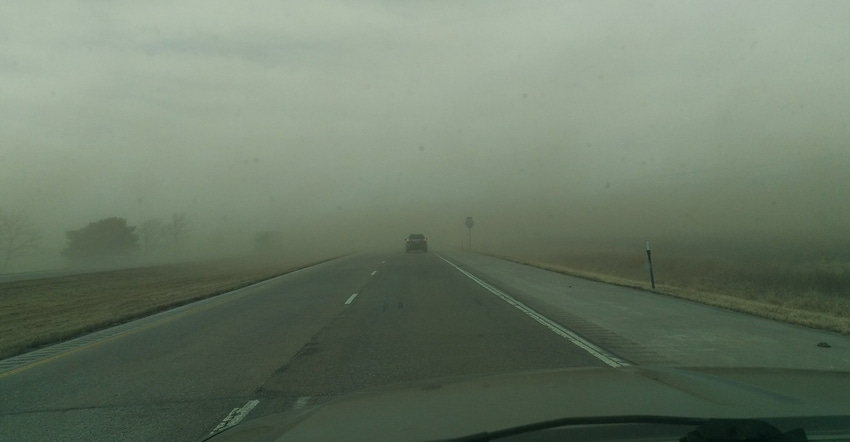May 25, 2018

A 20-plus car pileup and one human life lost. If ever there was a cost to associate with soil loss, this is it. Earlier this spring, a stretch of Interstate 80 in eastern Nebraska was blanketed with dirt and suffered blackout conditions conjuring images of the Dirty 30s.
The question is, why here? Why eastern Nebraska?
While the dry conditions, 40-mph winds and the level topography of the land didn’t help, Nebraska Extension educator Keith Glewen notes incidents like this aren’t new in this stretch of the interstate.
“You could argue that this was in a certain area, that there is the same kind of topography up and down the road, but there wasn’t a problem there. So what’s unique about the area where this occurred?” Glewen asks. “This has happened before. I remember years ago, I was driving east on I-80, and I looked to the east and all I could see was a big, black cloud. As I got closer, I realized it wasn’t a rain cloud; it was a dust storm.”
Perfect storm
Jenny Rees, Extension educator in the area, notes many factors were at play. However, one thing is clear: Tillage is a primary driver. “When you look at fields that have quite a bit of residue and reduced tillage systems that haven’t been worked with disking or conventional tillage, there was a big difference in how much soil was moving off of those fields. That was obviously was a big factor,” she says. (Watch this video showing no-till fields during high winds.)
One likely reason for more tillage in the area this spring and last fall is the excessive amount of downed corn in the area last fall — a result of high winds and poor ear shank strength in last year’s corn crop. “If growers didn’t have cattle to graze the downed corn, some tried disking. If they disked it in and they planted a cereal rye cover crop to keep the ground covered, it didn’t get much growth with the cold weather this winter and spring,” Rees says. “There were a lot of different factors. Some farmers are also using tillage for weed control.”
Paul Jasa, Nebraska Extension engineer, notes three things occur with wind-blown soil erosion.
“The smallest particles are picked up and carried away by suspension; that’s the dust cloud. Large particles can’t get picked up by the wind. But if there’s a bunch of larger particles moving along like a small sand dune, we call it ‘surface creep.’ Meanwhile, the very biggest soil particles roll and bounce. That’s called ‘saltation.’ Those particles might be a couple millimeters thick,” Jasa says. “One of the more dangerous things in saltation is basically a miniature bomb hitting small particles and knocking them loose. It can cause more detachment in addition to the wind itself.”
What’s at stake?
Jasa notes there are three key steps to prevent this soil from leaving the field. Many farmers this spring took measures to control dust, including turning on center pivots to wet the soil and settle the dust, and even putting up snow fence. However, the first line of defense, Jasa notes, is to keep wind off the soil completely with residue or growing vegetation.
Second, if a particle is detached, creating a barrier to block the wind will let the soil settle out, causing deposition. Third, stopping large particles from moving will prevent them from detaching any other soil.
“It’s a three-pronged approach, but the key is keep the wind off the soil surface in the first place, and if soil particles are detached, keep them from moving. The trouble with deposition is the detachment and transport already took place,” Jasa says. “First, keep the soil covered, protected, and something growing. If we have residue out there, keep it anchored and attached.”
How valuable is the soil leaving those fields? Jasa notes it’s difficult to say, but the first step might be putting a value on the production of that field and what’s lost due to erosion. This includes the nutrients, soil organic matter and infiltration ability lost in the soil particles that left the field. Incidents like those this spring are a reminder of the immediate dangers of wind erosion.
It isn’t just about no-till, residue or any one management practice. It takes a long-term systems approach to minimize soil erosion, Rees adds.
“One of my goals in York and Seward counties is to increase the use of minimum tillage methods, including no-till or strip till. Within that is increasing crop and livestock diversity [and] integration. This includes utilizing more small grains and cover crops, and utilizing more cattle on cornstalks,” Rees says. “I’m hoping to start discussing some of these things this fall and into winter. It’s probably going to be a slow process, but there is an increased awareness of what environmental conditions can cause soil loss, and awareness of how important it is to do everything we can to keep that resource for future generations.”
You May Also Like




